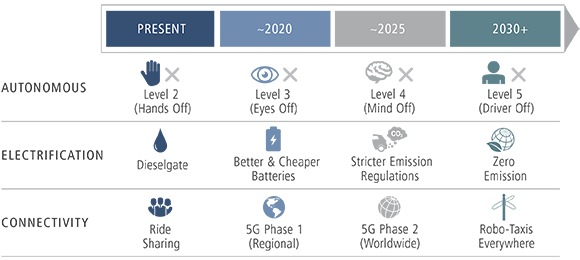Automobile-related technologies have been the subject of intense market interest, with the news often dominated by a few high-profile names and their changing fortunes, as they navigate lofty expectations, worries about their business models and questions as to the pace of innovation and consumer acceptance. But whether Tesla, Uber or Waymo are individually successful in seeking to dominate their respective niches in the near term is perhaps less important than the current journey being traversed by so-called next-generation mobility as a whole. And rather than thinking about utopian outcomes of fully self-driving cars, electrified vehicles and fleets of autonomous taxis, we believe it will be more fruitful to consider the opportunities along the road to the radical changes that will eventually occur.
At our firm, we like to think of next-gen mobility in terms of problem-solving. The $4 trillion global transportation industry (over $10 trillion if you include used vehicles) faces an array of serious issues: It is very unsafe, with some 1.2 million in traffic fatalities last year around the globe; it is dirty, with autos accounting for a large percentage of the CO2 emissions driving global warming; and it is inefficient, characterized by traffic jams, extended wait times and mismatches between people and available transportation.
Transportation: Problems Waiting for Solutions
Source: Aptiv.
Next-generation mobility offers potential solutions to all of these issues.
Safety. Human error causes about 95% of all traffic accidents, often the result of distracted driving. Autonomous braking systems can sense if the driver is not reacting to danger, and can slow or stop the car, or work with other safety features to take evasive action. Drivers often change lanes without realizing the approach of other cars, so blind-spot protection can provide warnings to avoid collisions. These and other “advanced driver-assistance systems” (or ADAS) promise to reduce accidents significantly.
Climate. Electric cars are seen as a key weapon in the battle against global warming. Particularly when using power generated by solar or wind, electric cars are a very clean mode of transportation. Governments are increasingly demanding that car companies reduce the carbon footprint of their new vehicles, and with diesel’s popularity waning, producers are leaning heavily on hybrid and electric sales to do so.
Efficiency. Connectivity among cars could be effective in reducing one of the longtime frustrations of personal transportation: inefficiency. Today, millions of people waste time in rush-hour traffic—congestion that’s made worse by behaviors such as rubbernecking, inattention and hesitation due to unpredictability of other drivers. If cars are able to communicate with each other and the surrounding infrastructure (e.g., traffic lights), many of these issues could go away. Connectivity is also closely associated with robo-taxis, which could add to efficiencies (reduced wait times) already achieved by ride-sharing companies. Over time, self-driving cars offer the potential to dramatically boost the utilization rates of vehicles, reducing the need for the vast areas dedicated to parking across our towns and cities, and freeing up resources for more productive uses.
Long Road Ahead
For all the potential, analysts and the media have often been overly optimistic about the timeline of advances, as well as market share growth and profitability of certain companies. In fact, the challenges ahead are substantial.
True automation, allowing transport from any location to any other location within driving distance, requires not only the ability to follow GPS directions, but to see and react quickly to other vehicles, road hazards and pedestrians, and the ability to operate in poor weather conditions. In addition to continued refinement of ADAS technology, the broad rollout of 5G technology (perhaps a decade away) will be essential to autos overcoming these obstacles and progressing to full automation. Finally, the transportation industry must resolve systemic issues tied to liability in case of accidents. All this means that investors may need to be satisfied in the near term with incremental advances. Robo-taxis, for example, may be limited to preset routes with little chance of disruption or variation, such as in theme parks, college campuses or short hops between transportation hubs, until 5G takes hold.
With electric cars, the key challenge has been evident for years: How do you make a battery that is powerful, charges quickly, lasts a long time on full charge (range), remains robust for many years, and is safe and affordable? Unfortunately, with the current state of battery technology, these elements are often in conflict and typically require robust and costly battery management systems. The removal of cobalt and the addition of higher nickel content to standard lithium battery chemistries can add power and range, but undermine stability and durability. Many of the batteries in use today are expensive, and while they work at the high end for a Tesla, they do not necessarily do so in the mass market. More broadly, the appeal of electric vehicles only extends as far as the resource base of the power grid. For example, Germany is heavily dependent on coal as a secondary source of electricity, undermining the “clean” label of its electrified vehicles. So, increased use of alternative fuels, whether solar, wind or even nuclear, will be needed to move the dial, along with more availability of charging stations in some markets.
That being said, Europe in particular is seeing an enormous push toward hybrid and electric vehicles, both from consumers and government. The issues around emissions from diesel cars seem to have been a key catalyst as European buyers became more concerned about their resale value. Toyota says that the proportion of its customers in Europe purchasing the hybrid variant of its car models has spiked from roughly 20% to 70% in the past year or so. Meanwhile, the European Union’s mandated caps on average CO2 emissions from new vehicles continue to increase, pushing manufacturers to make hybrid and fully electric cars a larger portion of sales.
Change Will Likely Be Gradual…
Key Developments and Estimated Timeframe
Source: Neuberger Berman, Smart, Plunkett Research, U.S. Department of Transportation. Autonomous driving capabilities are typically divided into five different levels or phases: At levels 1 and 2, a human monitors the driving environment, with the car’s systems providing (1) assistance or (2) partial automation. At levels 3 and 4, the car provides primary monitoring of its environment, with increasing degrees of automation. Level 5 represents fully automated driving. For illustration purposes only. Estimates are for your information only and they may not be realized.
…But Ultimately Pervasive
Many Aspects of our Transportation Systems Will Likely Be Disrupted
Source: Neuberger Berman.
Gauging the Opportunity
Despite the challenges, we are confident that game-changing innovation and connectivity will come eventually. In the meantime, we see an expansive array of opportunities across the next-generation mobility universe. Some examples:
- Although full automation is far away, it’s clear that many of the new driving aides and safety features developed for automation are quite popular with consumers, and will likely become more prevalent. Companies that provide key software and hardware in these areas are likely to enjoy strong growth.
- With government and consumer demand for electrification, we anticipate a continued drive by manufacturers to sell electric vehicles, which could benefit battery materials producers, as well as suppliers of chargers and other key equipment. With the need to make electrical grids cleaner, we see potential beneficiaries across the power grid.
- Within the robo-taxi industry, we believe that companies that can develop reliable, safe technology, or maintain a stable footprint of service, could achieve dominant positions as 5G and advances in technology take hold.
Success at this stage does not necessarily equate to success in the future. Some leading companies have raised capital by virtue of compelling growth stories. They will need to keep hitting their guidance and show potential for profitability to keep investors interested. Moreover, we would not recommend ignoring more traditional players who are able to adapt to the new landscape. For example, selling cars—even electric or automated ones—is not just about the automobile itself, but about services. The extensive dealership network of a company like Audi offers an effective distribution channel as well as a convenient way to provide maintenance. That said, auto companies may need to work to maintain their brands through distinctive design and features, such as entertainment and increased driving range. And they may need to continue and expand strategic relationships with, or acquire, technology providers to maintain leadership.
How Big Is the Opportunity?
Next-Gen Transportation: Potential Revenues ($ Billions) and Revenue Growth
Source: Neuberger Berman estimates, Google/Waymo. Represents total content spending on technologies required for electrification and autonomous functionality in cars, and for vehicle connectivity/robo-taxis. CAGR refers to compound annual growth rate. For illustration purposes only. Estimates are for your information only and they may not be realized.
Capitalizing on the many threads of the next-generation mobility story is a major challenge for investors. It requires an understanding of an array of industries, from manufacturers, to technology firms, to energy and materials producers, as well as the impacts that regulation and climate change may have on business models. Environmental, social and governance (ESG) factors across these areas may provide a useful lens with which to assess risks and market opportunities for companies. More basically, employing deep fundamental research across industries, sectors and individual companies can reveal nuances that can contribute to potential investment success in a growing and potentially transformational segment of the global economy.
The road ahead may be long, but it is filled with potential for those who can employ their expertise and insights to navigate it effectively.












